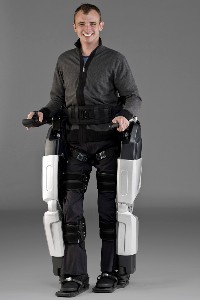An Auckland, New Zealand company has built a pair of robotic legs strapped to and worn outside the body that helps disabled people stand, walk, climb steps and ramps, and move in any direction. The company, Rex Bionics, says the robotic exoskeleton has undergone seven years of development and testing, including regulatory approval in New Zealand.
The device, called Rex by the company, is designed to supplement, not replace wheelchairs and scooters that can move people from one place to another. The company says Rex offers people normally wheelchair-bound more precise mobility in social and business places than wheelchairs or scooters may be able to provide.
The battery-powered Rex has been used so far with people suffering from spinal cord injuries, and can also be used by patients with multiple sclerosis and muscular dystrophy. Users must be able to operate the hand controls, including a joystick. In its current configuration, users can be no shorter than 4’8″ nor taller than 6’4″, nor weigh more than 220 lbs.
Rex Bionics says the device has gained the approval of New Zealand’s national ethics committee, and is completing tests for the European and Australian markets. The company is also seeking approval from the U.S. Food and Drug Administration.


 RSS - Posts
RSS - Posts
[…] This post was mentioned on Twitter by CTSciNet, Alan Kotok. Alan Kotok said: #Science #Business – Robotic Exoskeleton Provides Disabled More Precise Mobility http://bit.ly/bsTMDQ #ScienceBusiness […]
hey there I just wanted to comment your blog and say that I really enjoyed reading your blog post here. It was very informative and I also digg the way you write! Keep it up and I’ll be back to read more soon mate